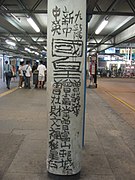Graffiti
Graffiti (plural; singular graffiti or graffito, the latter rarely used except in archeology) is art that is written, painted or drawn on a wall or other surface, usually without permission and within public view.[1][2] Graffiti ranges from simple written words to elaborate wall paintings, and has existed since ancient times, with examples dating back to ancient Egypt, ancient Greece, and the Roman Empire (see also mural).[3]
For other uses, see Graffiti (disambiguation).Graffiti is a controversial subject. In most countries, marking or painting property without permission is considered by property owners and civic authorities as defacement and vandalism, which is a punishable crime, citing the use of graffiti by street gangs to mark territory or to serve as an indicator of gang-related activities.[4] Graffiti has become visualized as a growing urban "problem" for many cities in industrialized nations, spreading from the New York City subway system and Philadelphia in the early 1970s to the rest of the United States and Europe and other world regions.[5]
In the early 1980s, the first art galleries to show graffitists to the public were Fashion Moda in the Bronx, Now Gallery and Fun Gallery, both in the East Village, Manhattan.[84][85][86][87]
A 2006 exhibition at the Brooklyn Museum displayed graffiti as an art form that began in New York's outer boroughs and reached great heights in the early 1980s with the work of Crash, Lee, Daze, Keith Haring, and Jean-Michel Basquiat. It displayed 22 works by New York graffitists, including Crash, Daze, and Lady Pink. In an article about the exhibition in the magazine Time Out, curator Charlotta Kotik said that she hoped the exhibition would cause viewers to rethink their assumptions about graffiti.
From the 1970s onwards, Burhan Doğançay photographed urban walls all over the world; these he then archived for use as sources of inspiration for his painterly works. The project today known as "Walls of the World" grew beyond even his own expectations and comprises about 30,000 individual images. It spans a period of 40 years across five continents and 114 countries. In 1982, photographs from this project comprised a one-man exhibition titled "Les murs murmurent, ils crient, ils chantent ..." (The walls whisper, shout and sing ...) at the Centre Georges Pompidou in Paris.
In Australia, art historians have judged some local graffiti of sufficient creative merit to rank them firmly within the arts. Oxford University Press's art history text Australian Painting 1788–2000 concludes with a long discussion of graffiti's key place within contemporary visual culture, including the work of several Australian practitioners.[88]
Between March and April 2009, 150 artists exhibited 300 pieces of graffiti at the Grand Palais in Paris.[89][90]
Environmental effects
Spray paint has many negative environmental effects. The paint contains toxic chemicals, and the can uses volatile hydrocarbon gases to spray the paint onto a surface.[91]
Volatile organic compound (VOC) leads to ground level ozone formation and most of graffiti related emissions are VOCs.[92] A 2010 paper estimates 4,862 tons of VOCs were released in the United States in activities related to graffiti.[92][93]




















